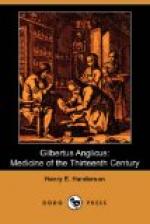Among the general symptoms of leprosy Gilbert enumerates a permanent loss of sensation proceeding from within (insensibilitas mansive ad intrinseco veniens) and affecting particularly the fingers and toes, more especially the first and the little finger, and extending to the forearm, the arm or the knees; coldness and formication in the affected parts; transparency (luciditas) of the skin, with the loss of its natural folds (crispitudines), and a look as if tightly stretched or polished; distortion of the joints of the hands and feet, the mouth or the nose, and a kind of tickling sensation as if some living thing were fluttering within the body, the thorax, the arms or the lips. There is felt also a sensation of motion, which is even visible also by inspection. Fetor of the breath, the perspiration and the skin are likewise noticeable. The localities affected lose their natural hair and are re-covered with very fine hairs, invisible except when held between the eye and the sun. The hair of the eyebrows and the eyelashes are lost—one of the worst of symptoms. There are present also hoarseness and an obstruction of the nostrils, without any visible cause. When the patient takes a bath the water runs off the affected localities as if they had been greased—another sign of evil omen. The angles of the eyes are rounded and shining. The skin, even when unaffected by cold, or other similar cause, is raised into very minute pimples, like the skin of a plucked goose. The blood in venesection has an oily appearance, and displays small particles like sand. Small tumors accompany the depilation of the eyebrows. Lepers are unusually and unduly devoted to sexual pleasures, and suffer unusual depression after sexual indulgence. The skin is tormented with a constant itching, and is alternately unduly hot or cold. Small grains are found under the tongue, as in leprous hogs.
Gilbert divides leprosy into four varieties, elephantia, leonina, tyria and allopicia, the pathology, symptoms and treatment of each of which are presented with wearisome minuteness and completeness. A long chapter, entitled “De infectione post coitum leprosi,” discusses the transmission of the disease by means of sexual intercourse, and suggests the possible confusion of lepra and syphilis.
The usual catalogue of specific remedies terminates the discussion.
An interesting chapter on small-pox[9] and measles, “De variolis et morbillis,” gives us the prevailing ideas relative to these diseases in England during the thirteenth century. Premising his remarks with a classification of diseases as follows:
Diseases universal and infectious—like morphoea, serpigo, lepra, variolae et morbilli.
Diseases universal but not infectious.
Diseases infectious but not universal—like noli me tangere.
Diseases neither infectious nor universal.




